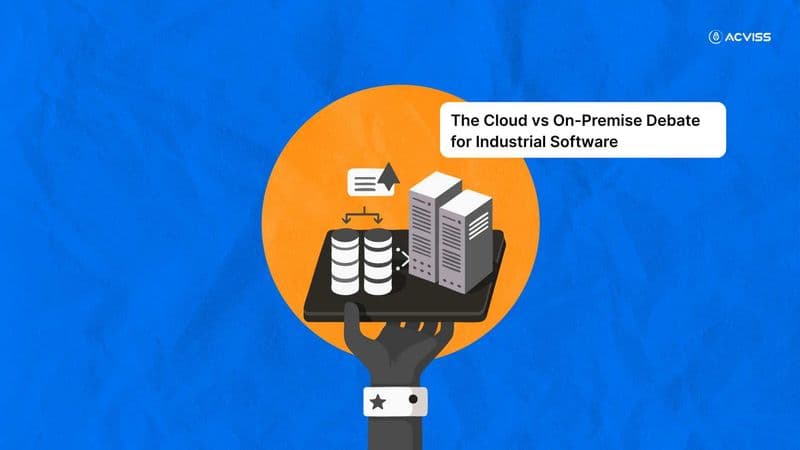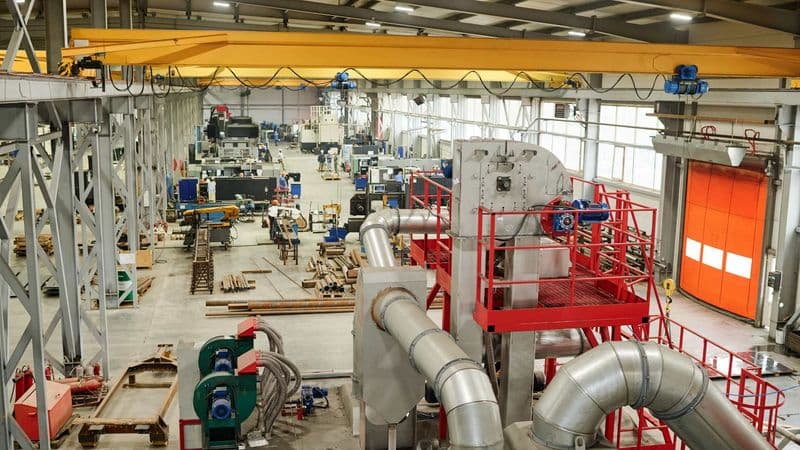Cloud or On-Premise Database for Industrial Tools? Why Offline-Centric System Still Wins!

The modern industrial ecosystem thrives on data. Whether it’s managing warehouse operations, monitoring supply chains, or ensuring product authenticity, every process now relies on software systems that promise precision, scalability, and visibility. Yet, as technology increasingly migrates to the cloud, one critical question continues to divide decision-makers: Should industrial software-particularly warehouse management and traceability systems, operate in the cloud, or remain on-premise?
It’s a debate that runs deeper than technological preference. It touches the very heart of operational control, data security, and business continuity. For industries dealing with critical or regulated products such as agrochemicals, pharmaceuticals, and electronics, the choice between cloud and on-premise defines not just efficiency but compliance, reliability, and resilience.
Understanding the Divide: Cloud vs On-Premise
Cloud-based software, at its core, hosts data and applications on remote servers accessed via the internet. It’s scalable, easy to update, and enables global accessibility. On-premise systems, on the other hand, operate locally, within the physical infrastructure of the organisation. Data is processed, stored, and secured within the company’s own environment.
In the industrial space, both models have strong cases. The cloud offers flexibility and real-time analytics, while on-premise systems provide reliability and autonomy, particularly in regions or sectors where uninterrupted internet access is not guaranteed.
For warehouse management tools and supply chain traceability platforms, the distinction is critical. A cloud-dependent system might promise visibility across continents, but what happens when connectivity falters in a remote agricultural site or a manufacturing unit in a low-network zone? Conversely, an on-premise system might lack the convenience of global data synchronisation, but it ensures operations never stop.
The Case for On-Premise and Offline-Centric Approaches
Industrial environments are not like typical office setups. They operate in varied terrains, from dense production zones to rural warehouses, and often under conditions where internet reliability fluctuates. In such contexts, offline-centric systems become not just preferable but essential.
An on-premise setup allows companies to process and store data directly on site. It enables warehouse management systems (WMS) and track-and-trace tools to continue functioning seamlessly, even during internet disruptions. Operators can scan, verify, record, and move inventory without any lag or downtime.
Moreover, when integrated with advanced product traceability and brand authentication tools, offline systems provide greater control over supply chain management. Businesses retain custody of their data, critical for meeting global regulations such as the EUDR (EU Deforestation Regulation), FDA traceability requirements, and emerging sustainability mandates in the US.
This is where hybrid approaches, blending local data control with periodic cloud synchronisation, are beginning to dominate industrial conversations.
Lessons from the Field: Acviss Origin’s Offline Operation
A recent example illustrates this shift perfectly. A global agrochemical company, operating across multiple continents with production units in Asia and distribution hubs in the US, implemented Acviss Origin, a blockchain-powered track and trace solution designed to ensure product verification and supply chain transparency.
The challenge was multifaceted. The company faced inconsistent network connectivity across several packaging and distribution units. Internet outages led to data delays, creating gaps in traceability records. For an industry under tight scrutiny for environmental and regulatory compliance, such lapses were unacceptable.
By adopting Origin’s offline operational capability, the company established an on-site, autonomous data management system. Operators could continue labelling, scanning, and recording product movement even without an active internet connection. Once connectivity was restored, the system automatically synchronised the locally stored data with the central server, maintaining an unbroken digital chain of custody.
This offline-first design not only improved operational continuity but also strengthened brand protection and IP protection measures by ensuring non-cloneable product identifiers remained verifiable regardless of network conditions.
The result: enhanced product authentication, reduced downtime, and better compliance visibility across international markets.
The Operational Edge: Why Offline Still Wins in Critical Environments

While cloud adoption continues to accelerate globally, projected to grow over 15% annually across industrial sectors, the on-premise and hybrid models are witnessing a quiet resurgence, particularly in regions with critical supply chains. The reasons are clear:
1. Reliability and Continuity
Factories, warehouses, and agrochemical plants often operate around the clock. An offline-capable system ensures continuity even in low-connectivity zones. Processes like scanning, packing, or product verification don’t halt when the network drops.
2. Data Sovereignty and Compliance
For industries regulated under region-specific laws, such as EUDR, EPA, or USDA, data control is vital. On-premise solutions allow organisations to store sensitive data locally, ensuring compliance with regional data protection standards.
3. Security and IP Protection
While cloud systems are secure, they expand the potential attack surface. An on-site system limits data exposure to external threats. In industries plagued by counterfeiting and IP theft, such as agrochemicals or electronics, localised systems combined with anti-counterfeiting technologies offer a critical defensive layer.
4. Cost Control
Although cloud systems reduce initial setup costs, recurring subscription fees and data transfer costs can add up, especially for large-scale operations. On-premise installations, while more capital-intensive initially, often provide a more predictable cost structure over time.
5. Integration with Physical Operations
Industrial and warehouse systems often need to integrate with legacy machinery, sensors, and IoT devices. Localised control allows tighter synchronisation and real-time operational responses.
The Supply Chain Traceability Imperative
As global trade becomes increasingly complex, product traceability is emerging as the cornerstone of modern supply chain management. Consumers, regulators, and investors now demand transparency, from the sourcing of raw materials to the final point of sale. A single missing data point can lead to compliance failures or loss of trust.
Offline-capable track and trace systems play an essential role in achieving this. They allow manufacturers to log product movements, verify authenticity, and ensure brand verification without depending solely on cloud connectivity.
For instance, in agricultural exports to the US, companies must provide verifiable data on origin, pesticide use, and sustainability compliance. Offline-enabled traceability solutions ensure this information is captured at every step, even in remote regions, guaranteeing seamless data consolidation later.
When combined with non-cloneable identifiers, like those deployed by Acviss, these systems make every product unit uniquely verifiable. This strengthens both trademark protection and product safety, mitigating the risks posed by counterfeit or diverted goods.
Balancing Efficiency with Control
In the US market, industrial modernisation has largely embraced cloud transformation. Yet, recent supply chain disruptions, cybersecurity concerns, and new sustainability directives have prompted manufacturers to reconsider their digital strategies.
Enterprises are now seeking hybrid frameworks, where core operations run on local servers for reliability, while analytics and dashboards operate in the cloud for broader visibility. The model delivers the best of both worlds: on-site reliability with centralised oversight.
A warehouse management system in this model can continue barcode scanning and inventory operations offline, while managers in other states or countries monitor synchronised reports in the cloud. Such a balance ensures business continuity and customer satisfaction while maintaining the integrity of product authentication processes.
For US manufacturers in critical industries, pharma, food, chemicals, and electronics, this approach also enhances brand protection by maintaining uninterrupted oversight of sensitive product lines.
Moving Beyond the Binary: The Rise of Hybrid Intelligence
The debate between cloud and on-premise is evolving into a discussion of coexistence. The future lies not in choosing one over the other but in orchestrating them intelligently. A hybrid solution allows real-time operations on-site and analytical intelligence in the cloud.
Modern industrial traceability platforms like Origin exemplify this future. They integrate localised data capture with centralised blockchain verification, ensuring transparency without compromising control. When network conditions are optimal, the system synchronises seamlessly. When offline, it continues to operate as a fully functional independent node.
This flexibility is becoming essential as global supply chains face increasing demands for accountability, sustainability, and efficiency.
The Bottom Line: Reliability is the New Innovation
As industrial enterprises continue their digital transformation journeys, the emphasis is shifting from innovation for innovation’s sake to reliable innovation, systems that keep operations moving regardless of external conditions. Offline-centric and on-premise solutions offer precisely that assurance.
Whether it’s a warehouse in rural Illinois or a production line in Southeast Asia, the capacity to operate independently of the internet defines resilience in modern manufacturing. And for companies navigating the dual pressures of global competition and regulatory scrutiny, such resilience can be the difference between compliance and crisis.
By combining offline-first architecture with robust track and trace capabilities, product authentication, and anti-counterfeiting solutions, organisations can build not just efficient supply chains, but trusted ones.
Conclusion
Choosing between cloud and on-premise software is no longer a simple matter of cost or convenience. It’s a strategic decision that influences every facet of supply chain management, from operational continuity to brand trust.
Offline-capable, on-premise solutions, such as those powered by Acviss Origin’s non-cloneable and offline-enabled traceability technology, demonstrate how industrial enterprises can stay both connected and independent, global yet grounded.
If your organisation is looking to strengthen its product traceability, enhance brand protection, and ensure operational reliability, it may be time to rethink your digital infrastructure.
Interested to learn more? Get in touch with us to discover how Acviss Origin can empower your supply chain with smarter, secure, and resilient traceability solutions.
